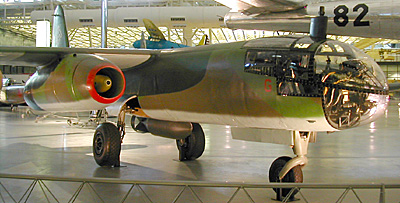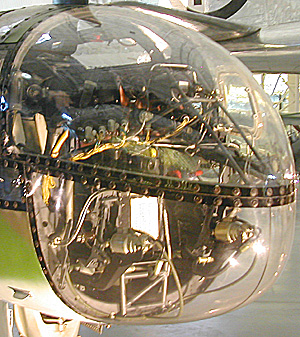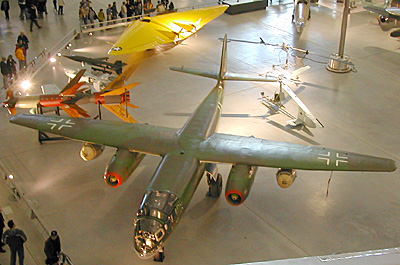 The wheeled trolley/skid used in the Ar 234 prototypes for take-off and landing as clearly impractical for an operational aeroplane, so plans for the Ar 234A production derivative of the Ar 234 V3 were dropped in favour of the Ar 234B. This utilised tricycle landing gear in which all three units retracted into the fuselage, an arrangement pioneered in the Ar 234 V9. The Ar 234B was intended for the reconnaissance bomber role with hardpoints under the fuselage and two engine nacelles for bombs up to 1102lb (500kg) weight.
The wheeled trolley/skid used in the Ar 234 prototypes for take-off and landing as clearly impractical for an operational aeroplane, so plans for the Ar 234A production derivative of the Ar 234 V3 were dropped in favour of the Ar 234B. This utilised tricycle landing gear in which all three units retracted into the fuselage, an arrangement pioneered in the Ar 234 V9. The Ar 234B was intended for the reconnaissance bomber role with hardpoints under the fuselage and two engine nacelles for bombs up to 1102lb (500kg) weight.
Some 20 Ar 234B-0 pre-production aircraft were followed by 210 Ar 234B-1 reconnaissance aircraft with drop tanks in place of bombs, and Ar 234B-2 reconnaissance bombers. The type entered service in September 1944, and the Ar 234B was complemented by just 14 examples of the Ar 234C with the revised powerplant of four 1764lb BMW 109-003A-1 turbojets.
 Close up of the Ar-234B cockpit.
Close up of the Ar-234B cockpit.
Country of origin: Germany
Type: (Ar 234B-2) single-seat reconnaissance bomber
Powerplant: two 19841b (8.825kN) Junkers Jumo 109-004B-1/2/3 Orkan turbojet engines and provision for two 1102lb (4.9OkN) Walter HWK 109-500 (R1-202b) RATO units
Performance: maximum speed 742km/h (461 mph); climb to 6000m (19,685ft) in 12 minutes 48 seconds with a 500kg (1102lb) bomb load; service ceiling 10,000m (32,810ft); range 1630km (1013 miles)
Dimensions: span 14.11 m (46ft 3.5in); length 12.64m (41ft 5.5in); height 4.30m (14ft 1.25in)
Weights: Empty 5200kg (11,464lb); maximum take-off 9850kg (21,715lb)
Armament: two 20mm fixed rearward-firing cannon in the underside of the rear fuselage, and an external bomb load of 1500kg (3307lb)
Specs and description from: Aircraft of WWII by Chris Chant (Fiedman/Fairfax, 1999, ISBN: 1-58663-303-1), a handy book covering 300 aircraft.
In between the R-1 and N-1M are a trio of German guided bombs: Hs293A-1 (dark blue, next to N-M1), Fritz X (white), and Hs117 (obscured, but the grey nose is partially visible between the Rheintochter and the wing of the AR-234B.
WWI
WWII
Japan: Kawanichi N1K2-Ja Shinden Kai (George)
US: Curtiss P40 Tomahawk
Post WWII
US: Northrop N-1M Flying Wing
Other
 The Arado 234B as seen from the third floor walkway. The yellow flying wing (top) is the N-1M, the helicopter the FA-330A, and the large grey-orange-dark yellow rocket off the wing of the AR-234B is the Rheintochter R-1.
The Arado 234B as seen from the third floor walkway. The yellow flying wing (top) is the N-1M, the helicopter the FA-330A, and the large grey-orange-dark yellow rocket off the wing of the AR-234B is the Rheintochter R-1.
UHC Displays
Germany: Focke-Wulf FW-190F
Germany: Arado AR-234B
Germany: Junkers JU-52/3m
Germany: Focke-Achgelis FA-330A
Germany: Rheintochter R1 Anti-aircraft Missile (Rhine Maiden)
Japan: Kawasaki Ki-45 Kai Toryu (Nick)
Japan: Aichi M6A1 Seiran
Japan: Kugisho Ohka Model 22 Cherry Blossom
US: Vought F4U Corsair
US: Lockheed P-38J Lightning
US: Boeing B-29 Superfortress "Enola Gay"
US: Grumman F6F Hellcat
US: Republic P-47D Thunderbolt
UK: DeHavilland DHC-1A Chipmunk
US: Lockheed SR-71 Blackbird
US: Space Shuttle "Enterprise"
US: Lockheed Martin X35b Joint Strike Fighter
Back to List of Historic Sites
Back to Travel Master List
Back to MagWeb Master List of Magazines
© Copyright 2004 by Coalition Web, Inc.
This article appears in MagWeb.com (Magazine Web) on the Internet World Wide Web.
Other articles covering military history and related topics are available at http://www.magweb.com